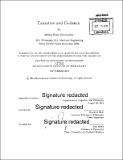Causation and evidence
Author(s)
Schumacher, Melissa Renée
DownloadFull printable version (7.137Mb)
Other Contributors
Massachusetts Institute of Technology. Department of Linguistics and Philosophy.
Advisor
Bradford Skow.
Terms of use
Metadata
Show full item recordAbstract
This work addresses questions about causation and evidence: How can we learn what causes what? Can we get evidence for objects that don't cause anything? And what is the evidential relationship between events in a causal loop? Structural equations accounts of causation seem to provide a good basis for discovering causal relationships through observation. But these accounts can sometimes give the wrong verdict in cases that are structurally similar to cases that they do get right. Distinctions between default and deviant states, and between more and less normal worlds, have been introduced to solve this problem. In "Defaults, Normality, and Control" I argue that both of these kinds of solution introduce new problems without solving the old one. I propose a different theory of causation based on the structural equations account, designed to capture the intuition that the causes of an event are whatever could have, by not occurring, most easily prevented that event. In the philosophical literature, Occam's Razor is standardly taken to be a constraint on the amount of (types of) objects a theory can be justifiably committed to. In "Occam's Razor and Philosophical Objects" I introduce an interpretation of Occam's Razor that doesn't fit that standard mold, but gives plausible answers to the questions "What is theoretical simplicity?" and "Why should we believe the simpler theory?". I then apply it to abstract and non-fundamental objects, and show that theories that include such objects need be no more complex than theories that don't. We can therefore be justified in believing such theories, even though they make the same predictions about observables as alternative theories. In "Playing Dice With a Time Machine: A New Puzzle About Causal Loops", I use an original puzzle case to bring out the problem of calculating the probabilities of events in a causal loop, and I propose a solution. I also point to some difficulties involved in reaching that solution.
Description
Thesis: Ph. D. in Linguistics, Massachusetts Institute of Technology, Department of Linguistics and Philosophy, 2015. Cataloged from PDF version of thesis. Includes bibliographical references.
Date issued
2015Department
Massachusetts Institute of Technology. Department of Linguistics and PhilosophyPublisher
Massachusetts Institute of Technology
Keywords
Linguistics and Philosophy.